Repowering Anju - Part 2 "The Exhausting Part"
11th November 2007- 11th January 2008
We already had the muffler, which in any case hadn't fitted in the spot where the mechanic assured us it would go. Our new design meant that the hot gas and cooling water would leave the engine separately, to be reunited just before the muffler, which was now to be positioned much higher in the engine room. Both of these changes would have a positive effect on the back pressure situation.
Once the location of the muffler was decided, Harry set to work to fabricate the dry riser to carry the hot air to the muffler. Due to its high temperature, this would need to be manufactured of steel pipe with a flexible stainless section, to allow for engine vibration. Once the flanged pipes were manufactured, they were fixed to the engine and supported from the engine room with rubber exhaust hangers.
The exhaust piping from the muffler to the outlet on the side of the boat would be fabricated of fibreglass exhaust pipe, with special angled pieces being glassed-in, to allow for the twists and turns that it would need to make. We got hold of the pipe and connectors, mocked everything up and cut the required pieces to size and prepared to fibreglass them together. Then, we decided to change the whole design to incorporate a check valve!!
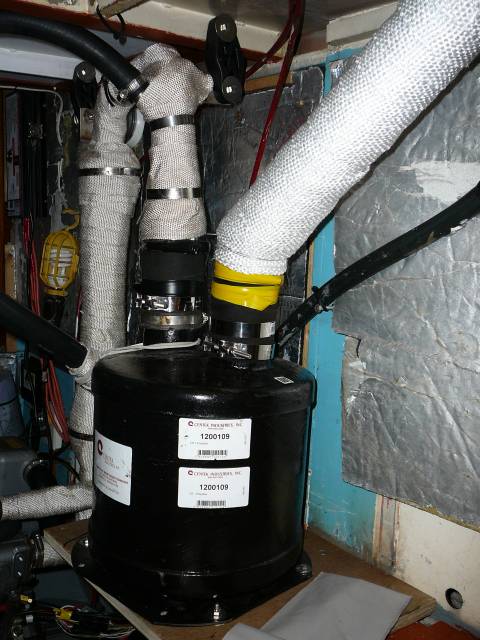
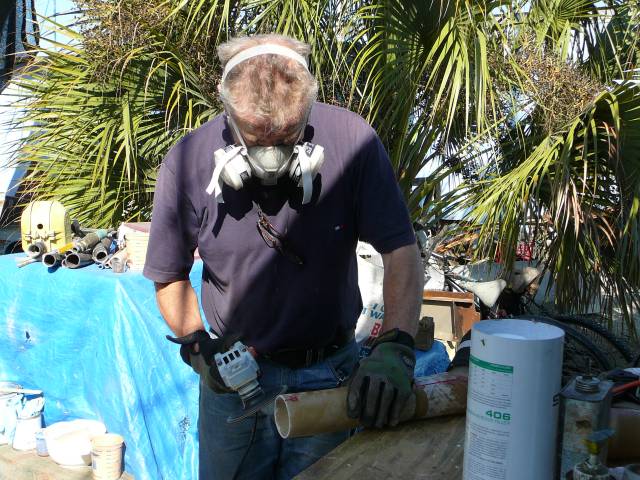
Cutting the fibreglass exhaust piping to size.......
checking the check valve.
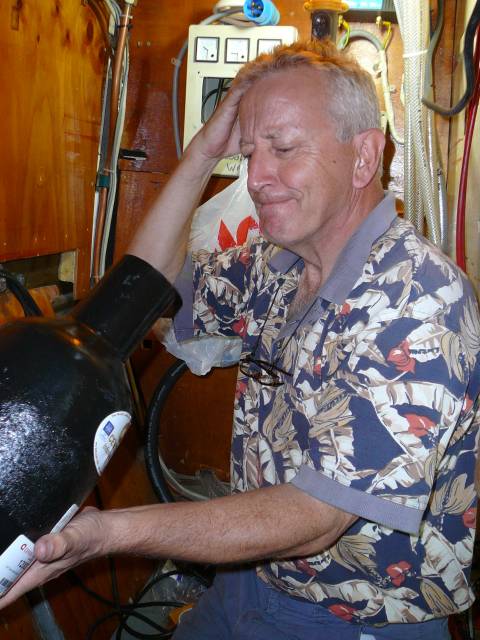
Next day the replacement valve was in our hands and was exactly the same as the previous one we'd had, despite assurances that it had been quality checked prior to despatch. We were back on the phone again, by now beginning to doubt our own sanity as the engineer on the other end talked us step by step through how to measure the size of a hole. "You'll see it is two and three quarter inches in diameter as specified", we were told. Not if the inches on our tape measure were the same as the inches on the engineer's tape measure, it wasn't!
The engineer even rang us back a little later, just to double check we knew how to measure. Eventually we gave him the batch number of the two check valves, both manufactured on the same day and he headed off to his warehouse.......Some time later we received another call. It seemed that particular day at the check-valve manufacturing plant had not been a good one and all the valves with that batch number were, like the two we had received, incorrectly manufactured. A new one from a different batch, personally measured by the engineer, was on its way to us. By now we were losing faith that anything we would ever order for the boat would be delivered right first time!
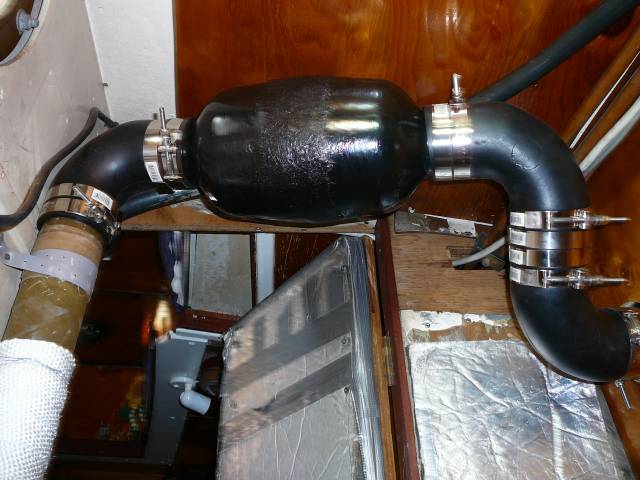
Check valve finally installed.
The through-hull fitting was installed with a clam-shell cover on the outside of the hull. Finally it was the moment of truth, time to turn the key and see if our new engine would work! First we had to improvise cooling water flow into the heat exchanger using a hose pipe. The next step in the handbook was to crank the engine a couple of times to get the oil around all its parts before starting it. "Crank it with your finger on the stop button", was the instruction. No instruction was given, however, on what to do if your over-eager new engine started first time, even when you had your finger on the stop button. After all the hard work it was such a relief to hear the sweet sound of the engine starting up!
On arrival, the new steering wheel wouldn't fit on the existing, naturally non-standard, spindle on the binnacle and our friend John came to our rescue yet again, machining everything to fit in his machine shop.
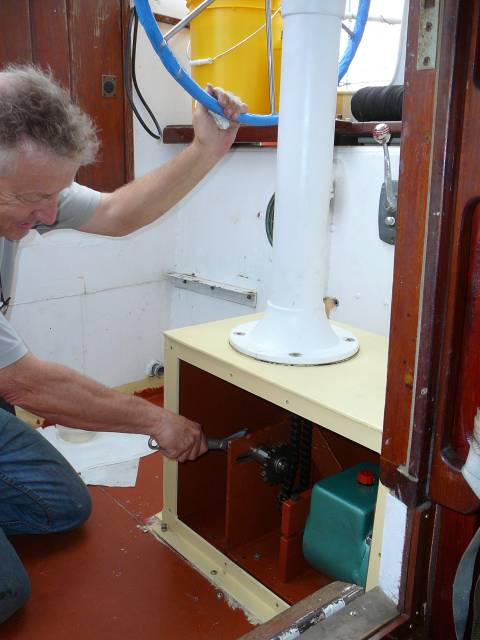
New steering set up
Next we needed to fill the system with new hydraulic oil and it took much phoning around to find the correct viscosity of oil for our system, which used a much lighter oil than the local standard. Another road trip to collect the barrel of oil and it was time to re-fill the system, ready for bleeding out of the air. The oil was poured into the top reservoir in the cockpit and then began to flow back out into the engine room through the new hoses manufactured by the expert! Aargh!
Back came the expert to make the hoses fit properly, the system was bled and seemed to work fine. It was time to hit the water!
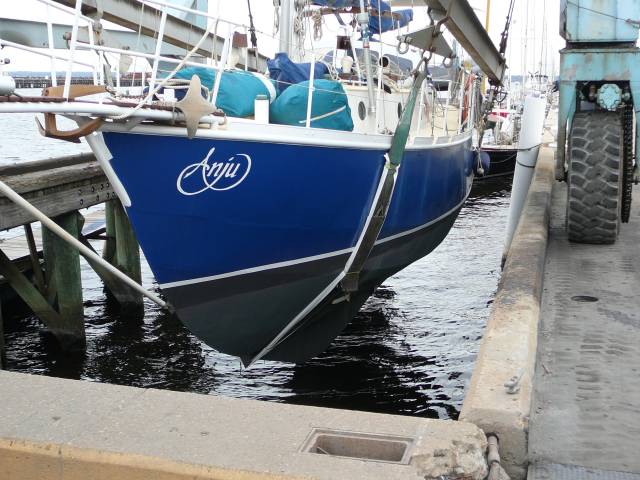
Saying we were nervous would have been a major understatement. Were the hull repairs good? Would the dripless stern fitting actually be dripless in water? Would the new engine run? Would the steering work? Countless other worries ran through our minds.
Anju, in true antipodean style, had no worries, entered the water like a true lady and took to water again without a hitch. She must have been happy to be back in her element after ten months ashore!
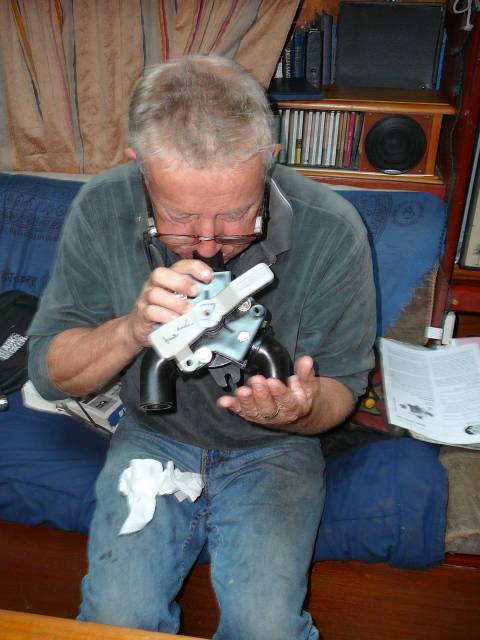
Blow don't suck Captain!
Next we realised that our on-board batteries were no longer up to par and although working fine with constant shore power to charge them, we were concerned about what would happen when we went to anchor. After more testing we decided to go ahead and replace them whilst we were still on the dock. This proved much easier than the previous time we'd done this from the dinghy, whilst at anchor in Grenada.
Finally after many engine trials we decided we were ready. After making a last provisioning run, the camper was cleaned and prepared for storage and we headed out for a couple of nights on the hook, anchored just off the marina, to get re-acclimatised to the cruising life. The supplies were all aboard, the weather looked promising and we were ready to go......then we got the call from the UK that we were needed at home due to serious illness in the family.........